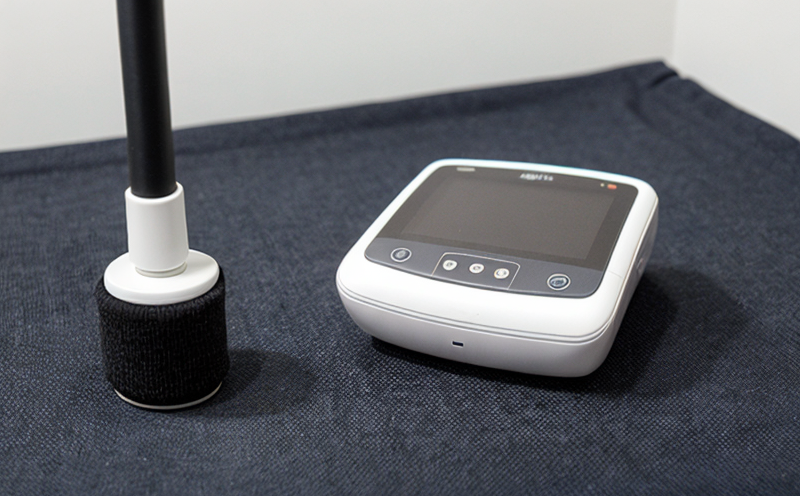Durability of conductive inks applied to stretchable fabrics
The durability of conductive inks applied to stretchable fabrics is a critical aspect that influences the performance and longevity of smart and functional textiles. This service focuses on assessing how well these inks withstand various mechanical stresses, environmental factors, and repeated use over time.
Conductive inks are increasingly used in the textile industry for creating electronics directly into fabric, enabling applications such as wearable technology, healthcare monitoring devices, and flexible sensors. Stretchable fabrics, especially those made from spandex or other elastomeric materials, present unique challenges due to their flexibility and ability to stretch and compress.
The durability of these inks is tested under a variety of conditions that simulate real-world scenarios. These include repeated stretching, bending, twisting, and exposure to heat, moisture, and chemicals. The tests are designed to mimic the dynamic nature of human movement and environmental exposure.
One of the most common test methods used for this purpose is ASTM D7510-18, which evaluates the adhesion strength of printed conductive inks on flexible substrates after mechanical abrasion. Another relevant standard is ISO 23611:2019, which provides guidelines for the evaluation of electrical properties of conductive textiles.
For stretchable fabrics, additional considerations are necessary to ensure accurate testing results. The specimen preparation involves carefully selecting a representative sample that mimics the intended final product in terms of weave and construction. The sample is then preconditioned according to specified temperature and humidity conditions before undergoing mechanical stress tests.
The instrumentation used for these tests typically includes sophisticated test machines capable of applying controlled stretching forces while measuring the electrical resistance or conductivity of the ink layer. High-resolution cameras may also be employed to capture any visible changes in the ink pattern over time, such as cracking or lifting.
Testing protocols often involve multiple cycles of stretching and releasing, followed by rest periods to allow for recovery if applicable. Environmental conditions, including temperature and humidity, are closely controlled throughout testing to ensure consistent results across different environments where these textiles might be used.
The reporting process involves detailed documentation of each test cycle, noting any changes in electrical performance or physical appearance of the ink layer. This information is crucial for understanding how well the conductive inks perform under specific conditions and can guide improvements in formulation or application techniques.
Benefits
The primary benefit of this service lies in its ability to provide comprehensive durability data that ensures product reliability. By identifying potential weaknesses early in the development process, manufacturers can make informed decisions about material selection and processing methods.
- Informed Decision Making: Data from these tests helps companies choose the best conductive ink and stretching technique for their applications.
- Predictable Performance: Understanding how inks behave under various conditions allows manufacturers to predict long-term performance accurately.
- Cost Efficiency: Early identification of issues reduces the need for costly redesigns later in development or production stages.
- Regulatory Compliance: Ensures that products meet international standards, thereby facilitating easier market entry and broader acceptance.
Quality and Reliability Assurance
The quality assurance process in this service involves several key steps aimed at ensuring consistent results and reliability. Each test specimen is carefully prepared to reflect the intended final product, with attention given to factors like weave type, fabric construction, and ink composition.
Tests are conducted under controlled environmental conditions to replicate real-world usage scenarios as closely as possible. This includes simulating typical temperature ranges, humidity levels, and exposure times that these textiles might encounter during their lifecycle.
Data from multiple test cycles is analyzed using statistical methods to determine trends and patterns in performance over time. This helps identify any significant degradation or failure points, allowing for targeted improvements in product design or manufacturing processes.
Regular calibration of testing equipment ensures that all measurements are accurate and consistent across tests. Documentation of each step in the testing process is maintained meticulously, providing a transparent record that can be reviewed by internal teams or external auditors if necessary.
International Acceptance and Recognition
- ASTM D7510-18: This standard is widely recognized for its comprehensive approach to evaluating the adhesion strength of printed conductive inks on flexible substrates.
- ISO 23611:2019: Provides guidelines for assessing electrical properties of conductive textiles, which are essential for ensuring compatibility with electronic components.
- EN ISO 17854: Focuses on the measurement of resistance in printed circuits, another critical aspect when dealing with conductive inks and fabrics.
These standards play a crucial role in ensuring that tests conducted align with global best practices, thereby enhancing confidence in the results and facilitating international trade. Compliance with these standards also helps manufacturers meet regulatory requirements and gain acceptance in diverse markets around the world.





